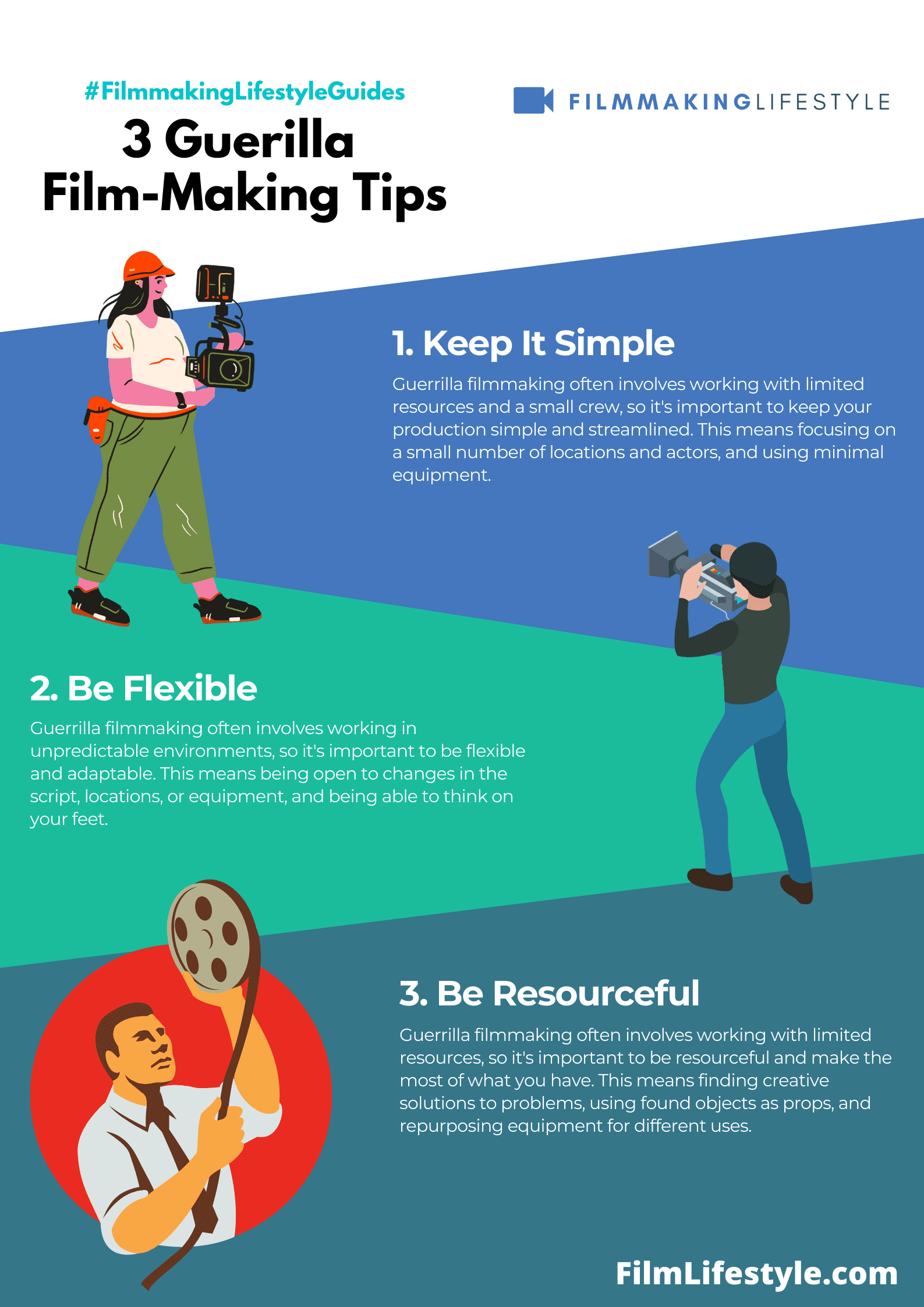Guerilla filmmaking is all about bending the rules to make your cinematic vision a reality, even when resources are tight.
We’re talking about crafting compelling stories with more creativity than cash.
It’s filmmaking at its most raw and inventive, where every limitation is a chance to innovate.
In this article, we’ll jump into essential guerilla filmmaking tips that’ll help you shoot your masterpiece without very costly.
From harnessing natural lighting to guerrilla-style editing, we’ve got the lowdown on making the most of what you’ve got.
Whether you’re a seasoned indie filmmaker or just starting out, we’re here to guide you through the thrifty, thrilling world of guerilla filmmaking.
Get ready to learn how to sidestep traditional filmmaking constraints and add that professional sheen to your project with a few clever tricks up your sleeve.
Guerilla Filmmaking Tips
What Is guerilla filmmaking?
The guerrilla filmmaker is someone who takes a more independent approach to filmmaking, typically eschewing the use of professional equipment and techniques in favor of a more “underground” aesthetic.
Guerrilla filmmaking is typically done on the cheap, with a low budget and low-quality equipment. While it has been around for decades, it has taken on an entirely new meaning in the digital age.
Guerrilla filmmaking is not just using cheap cameras to make a movie that looks amateurish. Instead, its true meaning lies in its philosophy behind the making of the film itself.
Choosing The Right Equipment
Selecting the ideal tools for guerrilla filmmaking can make or break your project.
We understand that budget constraints mean finding a balance between cost and quality.
First, consider the camera – your most crucial piece of equipment.
You don’t need the latest 8K model but look for one that delivers decent image quality and manual settings.
Here’s what to focus on:
- Camera sensitivity and low-light performance,
- Audio input for external microphones,
- Decent battery life and availability of affordable spare batteries.
Next on the list is sound.
Great audio is non-negotiable and often underrated in low-budget films.
Opt for a solid field recorder and a shotgun mic that can capture clear dialogue and ambient sounds.
Lighting doesn’t have to be expensive.
Use work lights or LED panels which offer solid performance without the hefty price tag.
Remember, natural lighting is your best friend, so plan your shooting schedule around the golden hour.
Stabilization is key for that cinematic feel.
A reliable tripod and perhaps a budget-friendly gimbal can work wonders.
They prevent shaky footage, improving your film’s overall quality.
Don’t overlook the importance of editing software.
There’s no need for high-end programs when starting out.
Even free software has the potential to create an impactful narrative.
Always aim for equipment that enhances your storytelling.
It’s not about the gear; it’s about how you use what’s at your disposal to convey a compelling tale.
Working With Natural Lighting
Harnessing the power of natural lighting can be a game-changer for guerrilla filmmakers.
It’s not just a budget-friendly solution – it’s also a way to give your film an authentic and beautiful look.
The golden hour – that magical time just after sunrise or before sunset – provides a warm, diffused light that’s highly sought after.
Planning your shoot schedule around these times can elevate your footage significantly.
Yet, natural lighting comes with its own set of challenges.
We must become adept at scouting locations and understanding the sun’s movement.
Reflectors and diffusers become essential tools in manipulating light, and we need to be nimble to adapt to changing conditions.
Films like Days of Heaven employed natural lighting to remarkable effect, proving that with skill and planning, the results can be stunning.
Here are some strategies for managing natural light:
- Scout your locations – Understand where and when you’ll get the best natural light.
- Use reflectors – Bounce light onto your subject to fill in unwanted shadows.
- Employ diffusers – Soften harsh sunlight, especially during midday shoots.
- Time your shots – Capitalize on dawn and dusk for softer hues and shadow play. Cloudy days shouldn’t be underestimated either.
The overcast sky acts as a natural diffuser, creating even, soft lighting conditions that reduce harsh shadows and contrast.
This can be particularly helpful for maintaining consistency in exposure and avoiding the need for excessive correction in post.
Natural lighting does more than illuminate your scene; it sets the tone and mood.
It defines the visual aesthetics and plays a vital role in storytelling.
Understanding how to work with what the sun provides means we can craft a visually compelling narrative, even with limited resources.
Movies such as The Revenant further underscore the emotional impact of relying on natural lighting, showcasing that sometimes, nature’s own light is the best director of photography there is.
Utilizing Unique Locations
In guerrilla filmmaking, the location breathes life into the narrative.
We understand that finding and securing the right places on a shoestring budget presents both challenges and opportunities.
Scouting for unique spots is an adventure in itself.
We’ve discovered that public spaces—parks, streets, abandoned buildings—often require nothing more than a permit, which can sometimes be free or low cost.
Permits aren’t the only consideration.
Even the most stunning location can falter if it doesn’t serve the story.
That’s why we focus on locales that amplify our film’s tone, mood, and character depth.
Here are strategies to use locations to their fullest potential:
- Research local folklore and history for inspiration,
- Network with locals for hidden gems,
- Use each location’s unique features to add production value.
Sometimes the environment itself becomes a character.
Take The Shawshank Redemption – the prison’s imposing edifice underscored themes of confinement and desperation.
Or in films like Blade Runner, where the futuristic cityscape is as central as the characters themselves.
We know that a clever approach to location can compensate for budget limits.
It’s all about embracing creativity and letting the environment inspire the storytelling.
With proper research and ingenuity, the world around us becomes an endless canvas for cinematic expression.
Creative Camera Techniques
Within the world of guerrilla filmmaking, innovation isn’t just a nicety – it’s a necessity.
Our ability to adapt creatively to limited gear and resources can lead to the discovery of fresh camera techniques that can define our film’s style.
Using handmade rigs constructed from everyday materials, we gain the flexibility to experiment with dynamic shots.
This hands-on approach not only saves money but also breeds originality in camera movements and perspectives.
Smartphone cameras have evolved to become formidable filmmaking tools.
Harnessing their compact size, we achieve angles and vantage points previously unimaginable with bulkier equipment.
Camera stabilization doesn’t always need expensive gimbals or Steadicams.
Effective substitutes like wheelchairs or shopping carts can provide surprisingly smooth tracking shots when budgets are tight.
Mastering the art of lighting with minimal gear is crucial:
- Natural light offers authenticity that is hard to replicate with artificial sources.
- Reflectors – even homemade ones – can redirect sunlight or any available light to illuminate scenes effectively.
Playing with focus is a powerful way to tell a visual story.
Skills like rack focusing bring attention to details that drive narrative without a word spoken.
We consider the impact of different frame rates and their ability to manipulate time perception within our film.
Slow-motion can underscore dramatic moments while time-lapses compress hours into seconds, illustrating transitions in unique ways.
Alternate shooting techniques such as POV shots place viewers directly into the action.
Films like Hardcore Henry pioneering this approach take audiences on a journey that traditional filmmaking methods seldom traverse.
It’s essential to embrace these inventive camera techniques.
They’re a testament to our resourcefulness and a reflection of our distinct voice as guerrilla filmmakers.
Clever Editing Tips
Editing is often where the guerrilla filmmaking process truly comes alive.
In the editing room is where we stitch together our creative visions, transforming raw footage into cinematic narratives that keep audiences engaged.
We recognize that editing on a budget requires us to be both resourceful and inventive.
By leveraging powerful yet affordable software like Davinci Resolve or HitFilm Express, we’re able to experiment with different styles without very costly.
The art of editing is enhanced through the use of dynamic cuts and transitions that maintain the momentum of our films.
We often employ:
- J-cuts and L-cuts to create a seamless flow between scenes,
- Match on action cuts for continuity,
- Creative use of cross dissolves to establish mood or passage of time.
Our approach includes trimming down scenes to their essence to keep the pace fast and prevent viewer fatigue.
It’s not uncommon for us to reduce a conversation to just a few seconds to convey the necessary emotion or information.
We understand the power of a well-placed montage.
Montages allow us to convey a large amount of information or the passage of time quickly, all while keeping viewers engaged through a carefully curated selection of clips set to music or narration.
Sourcing royalty-free music and sound effects from sites like Free Music Archive or Incompetech can add depth to our projects.
Sound layering helps establish atmosphere and can be done effectively even within a tight budget.
Last but not least, we know that color grading plays a critical role in visual storytelling.
By adjusting color temperature, contrast, and saturation, we create the desired mood and help our audience emotionally connect with the film.
Simple color corrections can often make a world of difference in the final look and feel of our guerrilla film projects.

In embracing these clever editing tactics, we continue to push the boundaries of what’s possible with guerrilla filmmaking, ensuring that our films not only tell a compelling story but do so with a professional polish that belies their modest origins.
Guerilla Filmmaking Tips – Wrap Up
We’ve armed ourselves with the tools and techniques to take our guerrilla filmmaking projects to the next level.
By harnessing the power of affordable editing software and employing creative cutting strategies we’re not just telling stories—we’re captivating audiences.
With our skills in dynamic editing and color grading we’re set to leave a mark in the world of indie cinema.
Let’s embrace the guerrilla spirit and turn our filmmaking dreams into impactful realities.
Frequently Asked Questions
What Is Guerrilla Filmmaking?
Guerrilla filmmaking is an independent filmmaking practice that emphasizes low-budget production strategies, resourcefulness, and a do-it-yourself approach.
It often involves minimal crews, natural lighting, and on-location shooting.
Why Is Editing Important In Guerrilla Filmmaking?
Editing in guerrilla filmmaking is crucial because it allows filmmakers to creatively piece together their story with limited resources, helping to maintain a fast pace and dynamic viewing experience that engages the audience.
Can You Use Professional Editing Software On A Budget?
Yes, there are affordable, even free, professional editing software options available, such as Davinci Resolve or HitFilm Express, which are perfect for guerrilla filmmakers looking to edit their projects without breaking the bank.
What Are Some Effective Editing Techniques For Guerrilla Filmmakers?
Guerrilla filmmakers can use a variety of editing techniques including dynamic cuts and transitions, concise scene trimming, informative montages, and strategic use of royalty-free music and sound effects to enhance storytelling.
How Does Color Grading Enhance Visual Storytelling?
Color grading is the process of altering and enhancing the color of a motion picture, video image, or still image.
In visual storytelling, it sets the tone and mood of the film, helps to establish a visual style, and can influence the emotional response of the audience.


